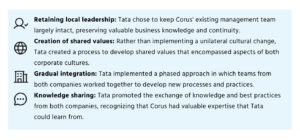Post-M&A integration strategies: this is how to make your merger or acquisition in India a success
Research shows that more than 70% of mergers and acquisitions between foreign companies fail to deliver the expected value due to integration challenges. The cultural, operational and legal differences between foreign and Indian business environments can add complexity to these integrations. We therefore walk you through the best practices for a successful post-M&A integration, focusing on culture, HR, IT and operational processes.

Integrating two cultures after M&A in India
The cultural gap between foreign and Indian companies can be substantial. For example, European organizations often have a flatter organizational structure where there is direct communication with each other and each employee is expected to be able to make autonomous decisions and contribute ideas.
Indian companies, on the other hand, are very hierarchical, meaning there is a strong need for a clear leader. As a result, job titles are also a lot more important in India than in other countries, and it is not always common to turn to someone higher up the ladder with ideas, criticism or feedback.
Effective cultural integration therefore unites core values that reflect the best aspects of both organizational cultures, rather than sticking to one model.
Take, for example, Tata Steel’s integration strategy when it acquired Corus Group. Here, Indian Tata set a good example by not introducing the traditional Indian business model into the European company being acquired. Instead, it opted for a more hybrid model, the key elements being:

This approach helped reduce resistance to change and provided higher staff retention compared to many other international mergers and acquisitions.
Human resources integration strategy
Integration of HR systems and practices is a sensitive area in mergers and acquisitions between foreign and Indian entities. Differences in labor law, compensation structures, performance appraisal and human resource policies must be carefully addressed.
For a successful HR integration, pay close attention to the following aspects:
- Talent retention: Identify key employees in both organizations. This goes beyond management. Talent often includes those employees with specific technical knowledge, strong customer relationships or unique market insights.
- Retention strategies: Develop ways to keep staff motivated and engaged. These can include financial incentives, such as bonuses or salary increases. But you can also consider providing growth opportunities within the organization where there are clear milestones established, or international experiences and exchange programs between sites.
- Challenging roles: Assigning integration responsibilities to key employees ensures that they remain engaged during the transition period. Special project roles in which employees serve as cultural bridge builders can both benefit and motivate the organization.
- Harmonization of policies: Develop a phased approach to harmonizing compensation and benefits packages while respecting local market practices and legal requirements. The integration of compensation systems need not be fully harmonized immediately. Instead, companies can opt for a “best of both worlds” approach. For example, performance-based bonus structures can be combined with the Indian emphasis on long-term incentives and loyalty rewards.
- Cultural training: As mentioned earlier, invest in cross-cultural training programs for all employees, with a particular focus on managers leading international teams.
Integrate IT systems and infrastructure after a merger or acquisition
Integrating IT systems can be a challenge in a merger or acquisition of an Indian company. This may have to do with how advanced the technology used is, compliance requirements and the company’s operational approach.
A comprehensive inventory of all IT systems, infrastructure, licenses and data assets is the first step. This should be followed by a strategic decision on which systems to retain, which to consolidate and which to replace. These decisions should be made based on business value, scalability, compliance requirements and future strategic needs.
Personal data storage and processing systems also deserve attention, as regulations in this area may vary slightly. Like the European GDPR, India has its own law, the Digital Personal Data Protection Act (DPDPA). European companies that comply with the GDPR will also automatically comply with the Indian law, but vice versa, some minor adjustments may need to be made to ensure this meets European standards.
Operational and process integration
For operational integration, the balance between standardization and local customization is crucial. In terms of production and supply chains, foreign and Indian operational strategies are in many cases complementary.
Foreign companies often bring advanced technologies, automation and stringent quality controls, while Indian operations can excel in cost efficiency, flexibility and scalability. Bringing these strengths together requires a detailed understanding of the current processes in both organizations.
Process standardization must be applied selectively. Core processes that directly affect product quality, safety and brand reputation should usually be standardized to the highest standards of both organizations. Support processes can retain more flexibility to meet local needs.










